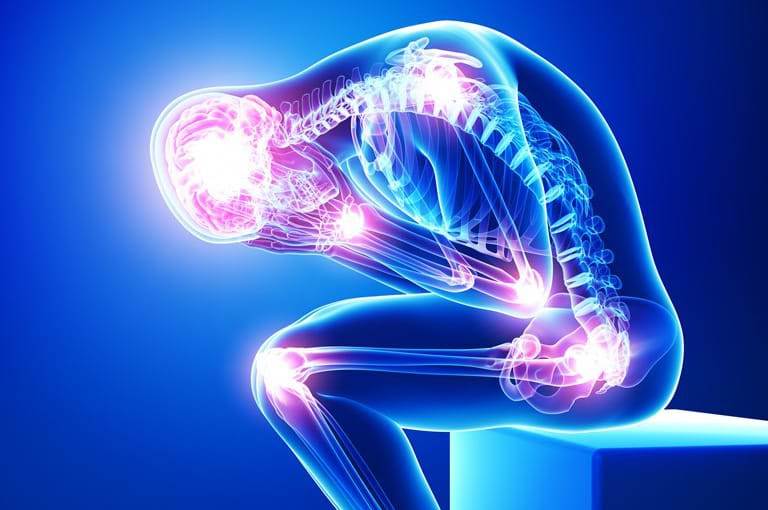
Meditation and Pain Management
PAIN AND THE MEDITATING BRAIN
In 1998, a search of the medical literature using the key words “mindfulness and mediation” yielded only eleven scientific studies. Today, the same search yields more than 600. A 2012 Google search of the same gives us almost 3 million results! According to the American Academy of Neurology, over the past 20 years, reams of studies show meditation changes actual brain structure. These go well beyond the placebo effect, defined as the effect we get from our positive expectations of a treatment rather than from the treatment itself. Researchers at the Johns Hopkins School of Medicine have investigated how meditation impacts our brain’s default mode network (DMN). This includes the self-talk constantly chattering in the background as we go about our day. The brain regions involved in the DMN include: medial pre-frontal cortex (front middle part of our brain) and posterior cingulate cortex (back middle part of our brain).
DMN tends to focus on past and/or future, e.g. “Why did I say something so stupid?” “I have so much work to do this week.” or “I’m in so much pain and it will never stop.” Meditators are better equipped to deal with this DMN. A recent functional MRI study revealed shorter neural responses in regions of the DMN of meditators compared to non-meditators. This suggests that regularly meditating enhances our ability to limit negative self-talk. Instead of dwelling on past mistakes or imagining problems in the future, we’re allowing ourselves to remain in the moment. Researchers suspect less DMN activity allows our brain to rest and remap itself. Such “rest” is healthy long-term, inasmuch our brain is re-tuning itself.
People with chronic painful illnesses, e.g. arthritis, fibromyalgia, debilitating migraines, Crohn’s, Diabetic neuropathy, etc. and/or neurological degenerative diseases, e.g. multiple sclerosis, Parkinson’s, etc. often feel betrayed by and alienated from their bodies, with feelings of helplessness and despair. Compounding this, they also may feel isolated and estranged from family and friends. Research confirms that those who meditate regularly experience less pain than those who don’t meditate. A 2011 study reported in Journal of Neuroscience shows a 40% reduction in pain intensity for beginner meditators. With a mere eight 30 minute meditation training, patients showed a 57% decrease in pain. In another study at the Wake Forest School of Medicine, researchers found that 20 minute meditation sessions for just three days helped a small group of volunteers reduce their sensitivity to mild electric shocks–even when they were NOT meditating at the moment of the shocks! Meditators do sense discomfort, but more effectively manage their emotional response to the pain. Meditators who experience distress while meditating show greater activity in areas related to body awareness, such as the anterior insula and somatosensory cortex.
MECHANICS OF MEDITATING IN PAIN

Meditators are more attuned to the sensations of pain, but don’t have the usual emotional reactions to it. Instead, they learn to recognize emotions such as anger, fear and anxiety without succumbing to the chain of pessimistic thoughts and behaviors that usually follow. Mindfulness and Pain ManagementNon-meditators tend to get stuck in the cascade of pessimistic cognitions and subsequent feelings. In anticipating pain, our sympathetic nervous system engages in a fight-or-flight response, which we then try to escape. In expending this energy, we feel more anxious, which feeds on itself, creating a negative feedback loop. In accepting the sensation of pain, we are no longer fighting it, which releases us into being more relaxed. We experience this as a fleeting moment. Because we see it as temporary, it is not threatening and no longer has a strong grip on our minds. Rather than dwelling on past pain or ruminating obsessively about future pain, meditation opens a gap between pain and us, paving a distance and allowing us space in which to rest.
In meditating, we play with looking at ourselves and our experience. The “play” comes from our doing this from many different perspectives. We look from below, from above, at an angle . . . our imagination and willingness to persevere–this is our only limit. Changing our perspective has instant benefits and is powerfully potent. In dealing with a chronic illness, for example, viewing pain as a battle to win or seeing the disease as something to conquer may set people up for disappointment and depression if they fail. Instead of fighting the inevitable, instead of flailing to slay the “enemy” of pain, we lay out a welcome mat for our experience. In the face of a roller coaster world of pain, maintaining equanimity is psychological medicine, soothing in spirit.
RISKS OF MEDITATION
Meditation is no panacea. As with any intervention, it has limitations and is contraindicated for some people, e.g. it may unearth painful memories. Those with psychotic disorders, severe depression and/or panic, or those suffering from post-traumatic disorders should undertake it under the supervision and guidance of an experienced professional. Meditation is not a replacement for thorough ‘conventional’ medical/psychiatric care and should not be practiced as sole treatment. Meditation is not sufficient reason to postpone seeing a physician for a medical problem. A sound and healthy physical platform is best for beginning a meditation practice.
A potential side-effect of meditation: people may develop a tendency to use it to escape from life. Because practicing meditation may offer profound relief, rather than confront the issue, it’s tempting to “escape into the breath.” This is akin to avoidance as coping mechanism and akin to an “addiction,” albeit one more easily justified. Another risk involves our becoming habitually detached from our experience such that we’re more observer than participant in life. Bearing witness by default and wriggling out of experience interferes with living and slipping into the present. Rather than remaining involved in a real and dynamic fashion, we’re dispassionate by default. This robs us of choice and freedom, the antithesis of what meditation offers at its best.
